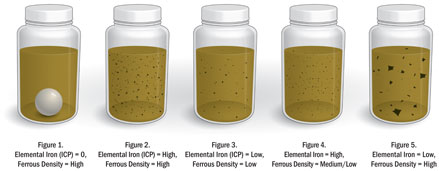Proper fluid analysis allows for detection of destructive contaminants
This form of oil analysis determines the presence and identification of wear particles produced as a result of mechanical wear, corrosion, or other machine surface degradation. It answers questions relating to wear, including:
- Is the machine degrading abnormally?
- Is wear debris produced?
- From which internal component is the wear likely originating?
- What is the wear mode and cause?
- How severe is the wear condition?

Dirt particulates, moisture, varnish, and gases are the primary contaminants that can cause damage to the equipment the lubricant is intended to protect. These contaminants can also reduce the performance and shorten the intended life of the lubricant. Mobile construction, waste collection equipment, and fixed equipment that depends on the reliable operation of heavy-duty machinery in manufacturing and power generation plants requires a systematic approach to maintaining lubricant cleanliness at levels specified by the equipment’s manufacturers.
Best practices monitoring involves pulling oil samples at regular intervals and sending them to
a lab for testing. Label the sample with the date and time, type of oil, and specific equipment in order to monitor changes in particle count over time. A simple patch test can be performed at your facility. With this test, an oil sample is run through a filter membrane and then observed through a microscope. Commercial patch test kits are widely available.
How to ensure accuracy
1. Consistency is key
Sample from an active stream in the system while the equipment is running and the oil is warm. Sample from the same place each time to ensure consistent results.
2. Regular intervals
Waiting too long between samples (1,000 hours vs 100) may lead to abnormal signs of wear. Regular sample intervals will ensure the lab can establish a reliable baseline to monitor any changes.
3. Be careful where you sample
Although the easiest place to take a sample is from the drain pan, this area is full of contaminants from earlier drains and debris around the drain plug. If the application allows, take a sample from the flow.
4. Use a clean, dry bottle
Only open the bottle when you’re ready to take the sample. Seal it quickly. Take approximately 4 oz. to represent a reservoir holding hundreds of gallons of oil. The lab uses a fraction for each of the many tests it performs.
5. Don’t fill the bottle
Leave room in the bottle so the technician can shake it to disperse wear particles that may have collected at the bottom.
6. Label the sample
Identify the exact oil viscosity, or SAE grade, in addition to the brand and fluid name. Label the type of equipment, number of hours on the unit, and date of last oil change. Use the same nomenclature each time. The more accurate information you give the lab, the more accurate the analysis.
7. Accountability
Assign someone to become familiar with the process to ensure consistency each time samples are taken.
